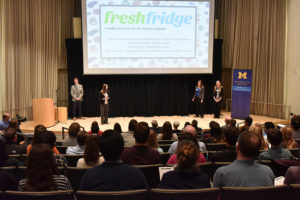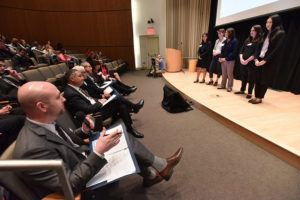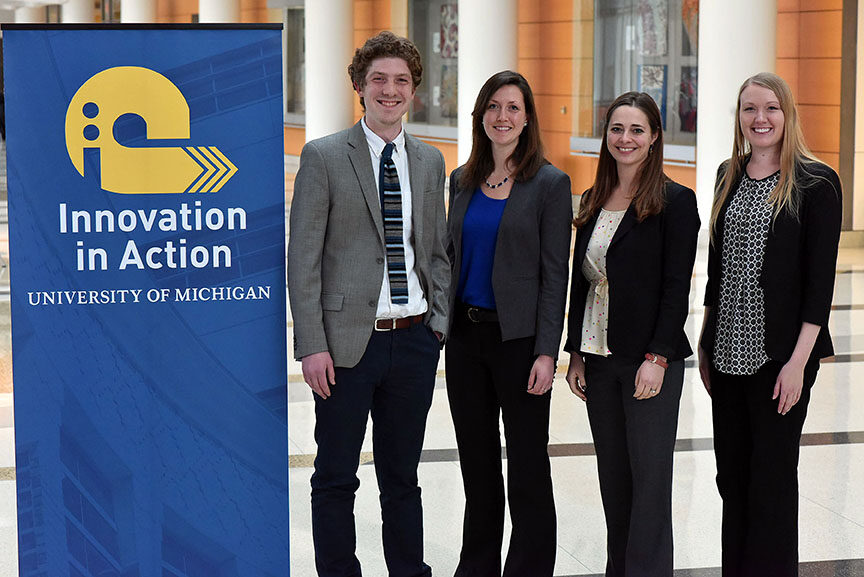
Fresh Fridge team: Trevor Dolan, LSA; Hannah Gordon, School of Public Health (SPH); Jana Stewart, SPH and School of Information (SI); and Christina Hecht, SPH and SI
What if your phone could tell you that the yogurt you bought weeks ago is about ready to expire? Or while at work you could check a list of what’s in the fridge to find out which ingredients are close to their expiration dates for that recipe you want to make tonight.
These are a couple of the functions a student group plans to make part of FreshFridge, an app they hope will make a dent in the $165 billion of food that goes to waste in the United States every year.
“Forty percent of food is wasted from farm to table,” Trevor Dolan, LSA student, told an audience at the final pitch session earlier this month for a competition called Innovation in Action (IIA). The average family of four throws away about $2000 of food each year, he added.
The smart phone application would scan a grocery receipt and, based on the day of the purchase, would calculate an expiration date using USDA guidelines for perishable food. Users could manually change it if they wanted to input the actual “best by” date. The app then would order items on a list according to expiration dates, soonest first, to serve as a reminder to use the items before they go bad.
The FreshFridge team just won first place in the third annual competition and now will have $10,000 to turn their idea into reality. Early conversations indicate the team also could have help from a regional supermarket chain that is very interested in development of the app.
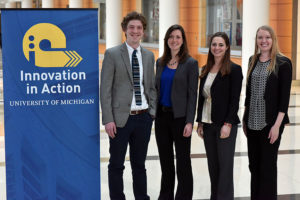
FreshFridge team: Trevor Dolan, LSA; Hannah Gordon, School of Public Health (SPH); Jana Stewart, SPH and School of Information (SI); and Christina Hecht, SPH and SI
Students from 15 of the university’s 19 schools and colleges have been working in multidisciplinary teams on this and other health and education solutions for the past six months, culminating in one big pitch to industry and education leaders at the finals.
Innovation in Action is a program from the School of Public Health that this year expanded to include a second track in partnership with the School of Education challenge, culminating in two separate final pitch events.
On the day of the final public health event a dozen teams were narrowed down to five that took the stage for a public presentation. At stake were prizes of $10,000, $7,500 and $5,000. The audience even got to vote on a favorite for a bonus $1,000, which went to FreshFridge as well.
The pitches from the finalists were sharp. They should have been by this time, as the teams have practiced them in front of experts and taken feedback for several weeks.
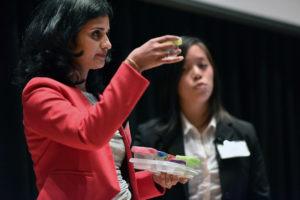
Dr. Anita Sebastian of the Healthykid finalist team shared the team’s plan to address child obesity by giving parents resources to ensure diets are well-balanced and well-proportioned. Looking on is teammate Patricia Yeh.
“This all takes time and a lot of soul searching,” says Ann Verhey-Henke, managing director of innovation and social entrepreneurship. “The students who make it through the program, I think it transforms them.”
Parisa Soraya, a graduate student in the School of Public Health, said the program gave her a toolkit to tackle any kind of problem in the field she’s studying, which is chronic health management.
Her group, Ditto, came in third place, earning the $5,000 prize to develop an app for people with chronic illnesses.
At the final pitch Soraya detailed the statistics about chronic illness: it impacts half of all adults or 183 million in the U.S., of whom one in four has multiple conditions. The illness results in 28 million missed workdays, revenue losses of $4.95 billion, and in 2010 cost the United States $1.95 trillion.
She said it was this project that helped her understand how little people know about chronic illness, and that she was surprised to find it affected “someone who looks just like me.”
“In fact, this individual is standing right next to me,” Soraya said of her teammate Brianna Wolin, College of Engineering student.
Wolin then pulled numerous items out of her backpack, explaining that as a student with type I diabetes and celiac disease, a Glucagon, epi-pen, several emergency snacks and a device that monitors her blood sugar every five minutes 24/7 were more essential than the school items she hauled around for her day on campus.
“I know what it means to live with an invisible illness,” Wolin told the audience, before the team members detailed their plan to develop an app that would put people with the same illnesses together for support, either virtually or in person.
The second place team was Confluence Health, a group that wants to provide community health workers with technology to help them manage patient interactions, with an end goal to improve overall care and help prevent hospital readmission.
The group hopes to use a gamification approach that would allow patients to participate in some sort of fun challenge and win badges, to keep them engaged with their app.
Over the three years of the competition teams have tackled a range of issues: mental health, food access, healthy eating, HIV management, the need for equipment and services in remote areas, infectious disease monitoring, healthcare delivery, diabetes care with minority populations, and fitness. Nearly all the top teams have resulted in the formation of a company and one group that developed a program to promote breastfeeding has really taken off, although it changed direction recently.
Anna Sadovnikova’s team called LiquidGoldConcept won the first year’s competition with a concept for a better breast pump that combined massage and suction, designed to make breastfeeding easier.
After Sadovnikova, now an M.D./Ph.D. student at University of California, Davis, spent a summer in Brazil learning the benefits of massage for successful breastfeeding, she realized their device was not the solution to the most common problems.
“I realized that we can’t keep putting more technology between mom and baby, we need to focus on education,” she said.
The team now has a multi-pronged approach that includes education for parents and health providers. For the parents, they are developing an online platform called the Breast Massage Knowledge Bank, the world’s first crowd-sourced, customized, and evidence-based collection of breast massage techniques. In order to train medical and nursing students in the basics of breastfeeding management, LiquidGoldConcept is developing a lactation simulation model.
“For me the most important part of IIA was giving me the confidence to believe in myself,” Sadovnikova said.
Verhey-Henke said the goal of Innovation in Action is not to launch startups but to help the students see that creation of a successful health care solution takes a lot of time and hard work, and is a long process. The students said it offered an experience they can’t get in a classroom.
“IIA was a unique opportunity to grapple with a public health challenge in a non-directive way. The open-ended nature of this social entrepreneurship competition really fosters creativity in a way that course work does not,” said Hannah Gordon, a member of the FreshFridge team and a health behavior and health education graduate student in public health.
“The workshops provided us with concrete skills in understanding consumer needs, communicating ideas, conducting a market assessment, and creating a business model. IIA also prompted us to get out into the field and talk to as many people as we could, as well as initiate real world partnerships.”
Gordon said one of the best things about Innovation in Action is that it opens doors. Testimonials from competition sponsors and judges support this.
“Talented. Spirited. Confident. Simply Impressive… Your students might very well be the most diverse and competent group of future leaders I have seen in practice,” one of the judges, Steven Escaravage of Booz Allen Hamilton, a corporate sponsor of IIA, wrote to Verhey-Henke. “For those considering consulting as a next step, I would be extremely interested in bringing my Leadership Team to Ann Arbor to discuss job opportunities… Our Firm needs future leaders and innovators.”
In addition to the annual competition that begins recruiting in September 2016, a new one-credit course led by Verhey-Henke called Entrepreneurship and Innovation in Public Health launched right after the competition with 30 students enrolled.

